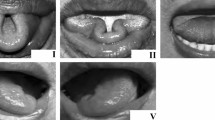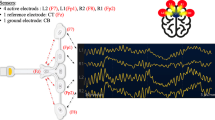Abstract
The present study had two purposes. The first was to provide variability data on objectively measured durational parameters of swallowing as accomplished by dysphagic patients secondary to stroke. The second was to examine the short-term effects of thermal application on these same durational measures. The study employed a cross-over design with each dysphagic stroke subject swallowing 10 times in both untreated and treated conditions. Two findings emerged: (1) swallowing durations in the 22 dysphagic stroke subjects were highly variable within and across subjects and have distributions that were nonnormal with nonhomogeneous variances; (2) thermal application reduced duration of stage transition (DST) and total swallow duration (TSD). Implications of these findings are discussed.
Similar content being viewed by others
References
Darby JK: Epidemiology of neurologic diseases that produce communication disorders. In: Darby JK (ed.). Speech and Language Evaluation in Neurology: Adult Disorders. Orlando: Grune and Stratton, 1985, pp 29–41
Palmer JB, DuChane AS: Rehabilitation of swallowing disorders due to stroke. Phys Med Rehab Clin N Am 2:529–546, 1991
Veis S, Logemann JA: The nature of swallowing disorders in CVA patients. Arch Phys Med Rehab 66:372–375, 1985
Rosenbek JC, Robbins J, Fishback B, Levine RL: The effects of thermal application on dysphagia after stroke. J Speech Hear Res 34:1257–1268, 1991
Horner J, Bouyer FG, Alberts MJ, Helms MJ: Dysphagia following brain-stem stroke: clinical correlates and outcome. Arch Neurol 48:1170–1173, 1991
Splainard ML, Hutchins B, Sulton LD, Chaudhuri G: Aspiration in rehabilitation patients: videofluoroscopic versus bedside clinical assessment. Arch Phys Med Rehab 69:637–640, 1988
Horner J, Brazer SR, Massey EW: Aspiration in bilateral stroke patients: a validation study. Neurology 43:430–433, 1993
Horner J, Massey EW: Silent aspiration following stroke. Neurology 38:317–319, 1988
Horner J, Massey EW, Brazer SR: Aspiration in bilateral stroke patients. Neurology 40:1686–1688, 1990
Logemann JA, Kahrilas PJ: Relearning to swallow after stroke-application of maneuvers and indirect biofeedback: a case study. Neurology 40:1136–1138, 1990
Linden P, Siebens A: Dysphagia: predicting laryngeal penetration. Arch Phys Med Rehab 69:637–640, 1983
Robbins J, Levine RL: Swallowing after unilateral stroke of the cerebral cortex: preliminary experience. Dysphagia 3:11–17, 1988
Robbins J, Levine RL, Maser A, Rosenbek JC, Kempster GB: Swallowing after unilateral stroke of the cerebral cortex. Arch Phys Med Rehab 74:1295–1300, 1993
Gordon C, Hewer RL, Wade DT: Dysphagia in acute stroke. Br Med J 295:411–414, 1987
Meadows JC: Dysphagia in unilateral cerebral lesions. J Neurol Neurosurg Psychiatry 36:853–860, 1973
Horner J, Massey EW, Riski JE, Lathrop MA, Chase KN: Aspiration following stroke: clinical correlates and outcome. Neurology 38:1359–1362, 1988
Logemann JA: Evaluation and Treatment of Swallowing Disorders. San Diego: College-Hill Press, 1983
Robbins J, Hamilton JW, Lof GL, Kempster GB: Oropharyngeal swallowing in normal adults of different ages. Gastroenterology 103:823–829, 1992
Logemann JA: Manual for Videofluoroscopic Study of Swallowing. San Diego: College-Hill Press, 1986, p 34
Mills H: Survey of Dysphagia Services in the Veterans Affairs Healthcare System. Alvin C. York Veterans Affairs Medical Center, Murfreesboro, TN, 1991
Lazzara GL, Lazarus C, Logemann JA: Impact of thermal stimulation of the triggering of the swallowing reflex. Dysphagia 1:73–77, 1986
Rosenbek JC: Efficacy in dysphagia. Dysphagia 10:263–267, 1995
Selinger M, Prescott T, McKinley R: The efficacy of thermal stimulation: a case study. Rocky Mtn J Comm Dis 8:21–23, 1990
Folstein MF, Folstein SE, McHugh PR: “Mini-Mental State,” a practical method for grading the cognitive state of patients for the clinician. J Psychiatr Res 12:189–198, 1975
Selinger M, Prescott TE, Hoffman I: Temperature acceleration in cold oral stimulation. Dysphagia 9:83–87, 1994
Shapiro SS, Wilk MB: An analysis of variance test for normality. Biometrika 52:591–611, 1965
Snedecor GW, Cochran WG: Statistical Methods, 7th ed. Ames, IA: The Iowa State University Press, 1980
Page EB: Ordered hypotheses for multiple treatments: a significance test for linear ranks. J Am Stat Assoc 58:216–230, 1963
Kennedy JG, Kent RD: Physiological substrates of normal deglutition. Dysphagia 3:24–37, 1988
Dubner R, Sessle BJ, Storey AT: The Neural Basis of Oral Facial Function. New York: Plenum Press, 1978
Rowe MJ, Sessle BJ: Responses of trigeminal ganglion and brain stem neurons in the cat to mechanical and thermal stimulation of the face. Brain Res 42:367–384, 1972
Pommerenke WT: A study of the sensory areas eliciting the swallowing reflex. Am J Physiol 84:36–41, 1928
Miller AJ: Physiology and pathophysiology of oral and pharyngeal stages of swallowing. Postgraduate Dysphagia Training Conference. Iowa City, IA, 1993a
Miller AJ: The search for the central swallowing pathway: the quest for clarity. Dysphagia 8:184–195, 1993b
Kerr FWL: The divisional organization of afferent fibers of the trigeminal nerve. Brain 86:721–732, 1963
Rosenbek JC: A response curve for tactile-thermal application in the treatment of dysphagia resulting from stroke. Rehabilitation Research and Development grant, #C93-689AP, 1994
Wilson-Pauwels L, Akesson EJ, Stewart PA. Cranial Nerves: Anatomy and Clinical Comments. Toronto: B.C. Decker, Inc, 1988
Logemann JA, Pauloski BR, Colangelo L, Lazarus C, Fujiu M, Kahrilas PJ: Effects of a sour bolus on oropharyngeal swallowing measures in patients with neurogenic dysphagia. J Speech Hear Res 38:556–563, 1995
Kenshalo DR: Somesthetic sensitivity in young and elderly humans. J Gerontol 41:732–742, 1986
Guyton AL: Textbook of Medical Physiology, 8th ed. Philadelphia: WB Saunders, 1991
World Health Organization. International Classification of Impairments, Disabilities and Handicaps. Geneva, Switzerland, 1980
Author information
Authors and Affiliations
Additional information
This work was performed at the William S. Middleton Memorial Veterans Hospital; Madison, Wisconsin
This is publication number 95-10 of the Madison Geriatrics Research Education and Clinical Center
Rights and permissions
About this article
Cite this article
Rosenbek, J.C., Roecker, E.B., Wood, J.L. et al. Thermal application reduces the duration of stage transition in dysphagia after stroke. Dysphagia 11, 225–233 (1996). https://doi.org/10.1007/BF00265206
Issue Date:
DOI: https://doi.org/10.1007/BF00265206




